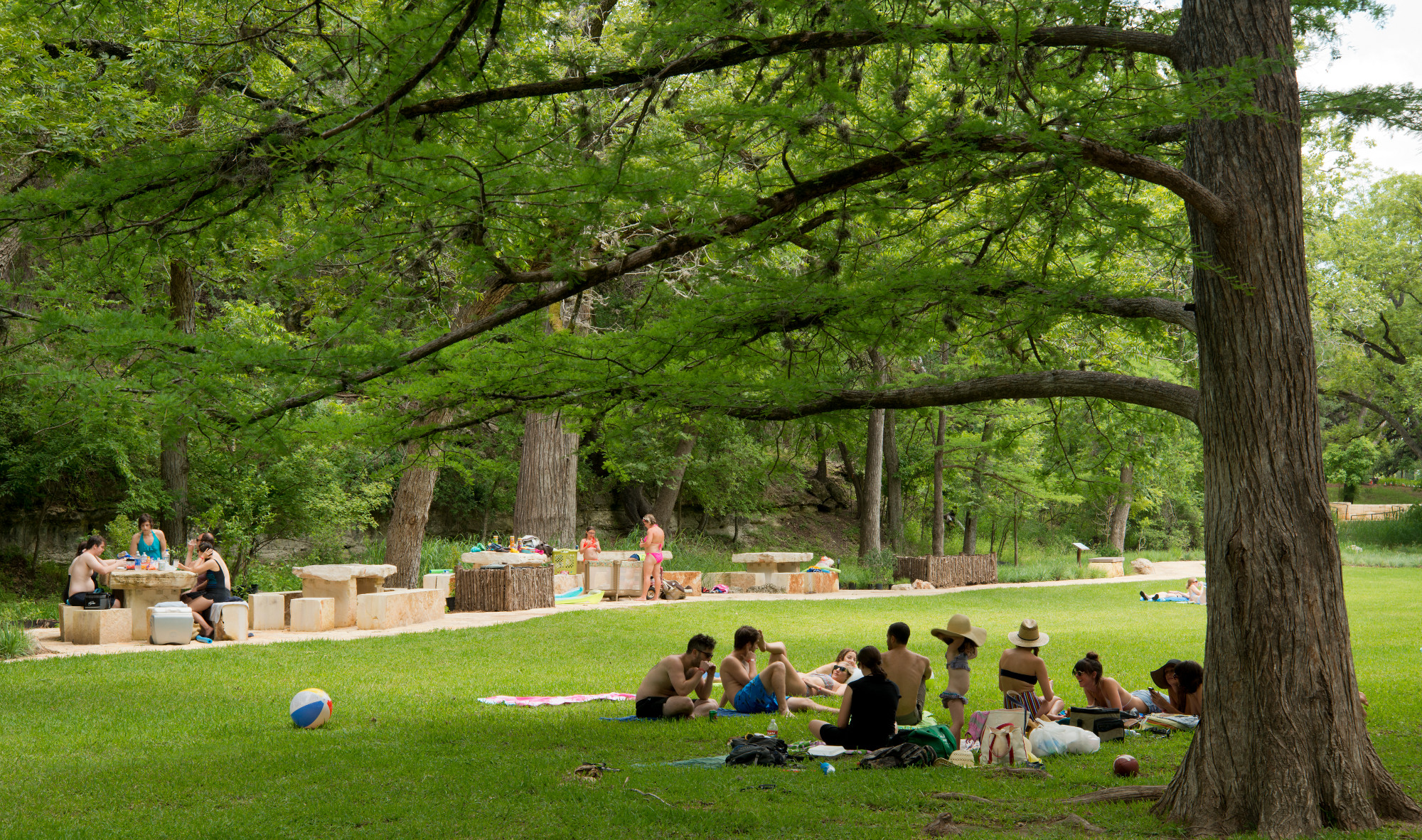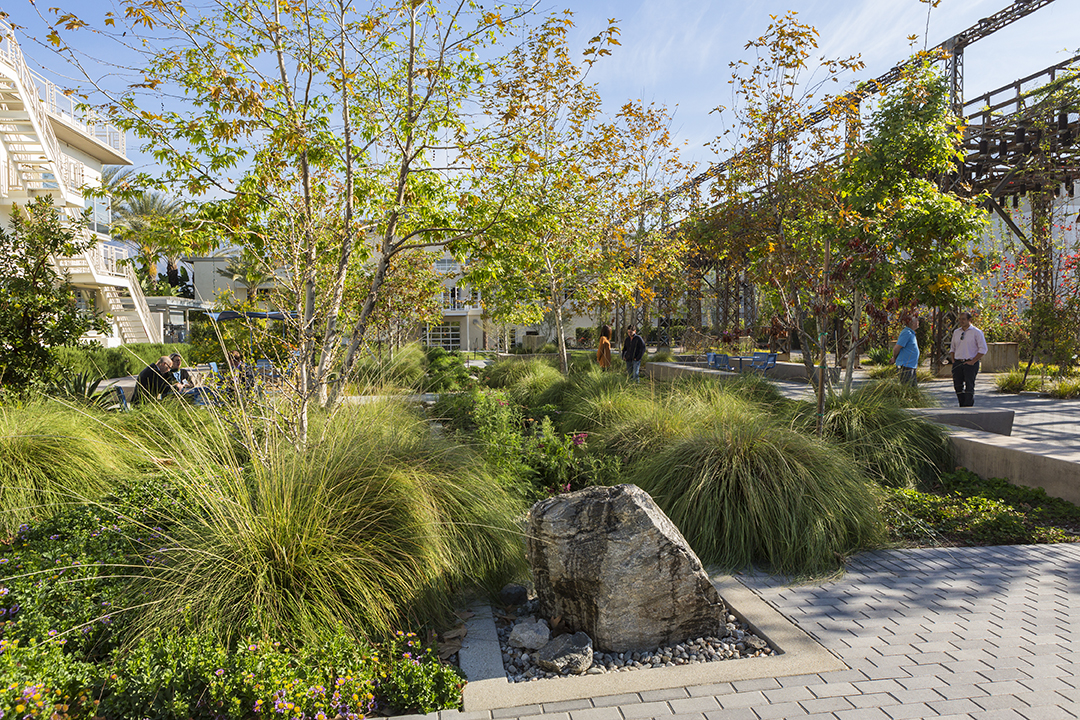In my role as director of the Sustainable SITES Initiative® at the Lady Bird Johnson Wildflower Center, I observed the development of numerous projects. Too often, the landscape is seen as an afterthought – something to be altered and shaped once elements like buildings and roads are finalized. Rather than be an afterthought, though, how can a site or place inform the design process? How can humans be reconnected with nature, particularly at a time when half of the world’s population lives in urban areas, and that number is only expected to rise? How can we create beautiful places that are also healthy, functional and resilient?
These are questions and concerns that infused the thinking and drove the development of the Sustainable SITES Initiative (SITES®). Embracing an interdisciplinary approach, the SITES program was informed by a group of prominent and forward-thinking practitioners, scientists, policy-makers, and academics with diverse expertise in soil, vegetation, hydrology, materials, and human health and well-being. Founded in 2006 by the Lady Bird Johnson Wildflower Center at The University of Texas at Austin, the U.S. Botanic Garden, and the American Society of Landscapes Architects, the SITES program set out to develop a rigorous tool based in science and best practices in landscape design, ecological restoration, and related fields.
We were trying to solve a complex problem. This voluntary system had to be accessible to practitioners yet raise the bar for site sustainability, setting clear benchmarks and redefining the process for land design and development. It also had to be comprehensible for professionals from a variety of backgrounds, including landscape architects, designers, planners, engineers, architects, developers, policy makers, ecologists among others that work on land design and development.
From the outset, SITES embraced the concept of ecosystem services as its core framework.
Ecosystem services are goods and services of direct or indirect benefit to humans that are produced by ecosystem processes in nature. This term was developed to raise awareness of nature’s value by describing, and sometimes quantifying, the many benefits humans depend on for survival. We know these benefits can also be found in built landscapes if they are designed and managed with those services in mind. The central message of SITES is that any project – whether the site of a corporate campus, city park, academic institution or residential yard – has the potential to conserve, restore and create ecosystem services.
How to go about this vast undertaking? We had a good model in the LEED green building program developed by the U.S. Green Building Council (USGBC), and we used that to inform the development of SITES, shifting the focus beyond the building to reveal the necessity of healthy, functioning landscapes in achieving overall sustainability. Unlike buildings that typically depreciate over time, high-performance landscapes appreciate in value by continuing to provide a variety of benefits to a community such as conserving resources, managing stormwater, cleaning air, reducing urban heat island, and improving human health and well-being. Sustainable landscapes can create ecologically resilient places better able to withstand and recover from episodic floods, droughts, wildfires, and other catastrophic events.

Blue Hole Regional Park, Wimberley, TX. Picnic area crafted from repurposed limestone and cedar wood. Credit: Dale Horchner, Design Workshop
Since 2006, SITES staff and numerous technical advisors have been actively involved in researching the criteria for a sustainable landscape.
In order to identify clear and rigorous guidelines and performance-based benchmarks, the team examined every stage of the site development process from site selection to design, construction and management. Striving to be transparent, inclusive, and thorough, the process included three published reports, three public comment periods, and a multi-year pilot program to field test the 2009 SITES Rating System (or “v1”). This included contributions from more than 70 technical experts, thousands of comments, and feedback provided by more than 150 pilot projects in the U.S. and abroad.
The pilot phase was hugely important for validating the rating system and helping us work out the final kinks. By the end of the pilot phase, 47 pilot projects had achieved certification. Located in 20 U.S. states, they ranged in size, program, budget and context; they represented public, private-public, and privately funded projects. The certified projects were mostly located in urban (56 percent) and suburban (38 percent) locations. An overwhelming amount of redevelopment projects (83 percent) became certified, of which 65 percent were on previously developed (greyfield) sites, the remaining on brownfields. This demonstrates how SITES supports redevelopment projects for their unique capacity for restoration and regeneration of ecosystem services on those sites and in those communities.
Altogether, these certified projects impacted 790 acres, with 28 percent of them covering sites that were about one acre or less (64 percent were on sites five acres or less). Many of the pilot projects optimized their sites to provide multiple benefits, including improvements to wildlife habitat, reduction in pollution and waste, regulating climate, cleaning air and water, increasing public accessibility and enjoyment, and managing stormwater using green infrastructure strategies.
Another consideration in our development of SITES was diversity of site types and locations. We know that development will continue to occur, whether on an urban site or a greenfield site, and the system was designed to work on all of them. With population increasing in urban areas, the need to bring nature into the city is critical. Therefore, redevelopment of previously developed, contaminated (brownfield) and infill sites is viewed as an ideal opportunity to restore and create ecosystem services where they are most needed.
Some prerequisite and credits in the SITES v2 Rating System limit and, at times, prevent development on healthy (greenfield) sites while promoting and rewarding projects that redevelop degraded sites. However, it is possible for a greenfield development to achieve certification. The majority of SITES credits use performance-based benchmarks as a means to comply with credit requirements, which focuses on performance or function, rather than prescriptive strategies or features. This gives the project flexibility and creativity in reaching those outcomes that may be unique for every project and situation.
In June 2015, Green Business Certification Inc. (GBCI) officially acquired the SITES Rating System from The University of Texas and ASLA. GBCI is the premiere organization independently recognizing excellence in green business industry performance and practice globally. GBCI exclusively administers project certification and professional credentials and certificates of LEED, EDGE, PEER, WELL, SITES, GRESB and Parksmart. The Wildflower Center and ASLA continue to support GBCI in the creation and implementation of the SITES credentialing and certification offerings. This includes training, project reviews, and providing education opportunities.
Danielle Pieranunzi is the director of the Sustainable SITES Initiative.
Top image: Burbank Water and Power – Ecocampus, Burbank, CA. An abandoned utility tunnel in the Centennial Courtyard was re-purposed into a phytoextraction channel. Stormwater is diverted into this channel, where a carefully selected mix of plant material cleans the water and infiltrates into the subgrade. Credit: Heliphoto






Leave Your Comment